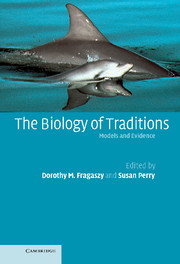Book contents
- Frontmatter
- Contents
- List of contributors
- Preface
- Acknowledgements
- 1 Towards a biology of traditions
- 2 What the models say about social learning
- 3 Relative brain size and the distribution of innovation and social learning across the nonhuman primates
- 4 Social learning about food in birds
- 5 The cue reliability approach to social transmission: designing tests for adaptive traditions
- 6 “Traditional” foraging behaviors of brown and black rats (Rattus norvegicus and Rattus rattus)
- 7 Food for thought: social learning about food in feeding capuchin monkeys
- 8 Traditions in mammalian and avian vocal communication
- 9 Like mother, like calf: the ontogeny of foraging traditions in wild Indian Ocean bottlenose dolphins (Tursiops sp.)
- 10 Biological and ecological foundations of primate behavioral tradition
- 11 Local traditions in orangutans and chimpanzees: social learning and social tolerance
- 12 Developmental perspectives on great ape traditions
- 13 Do brown capuchins socially learn foraging skills?
- 14 Traditions in wild white-faced capuchin monkeys
- 15 Conclusions and research agendas
- Further reading
- Index
- References
14 - Traditions in wild white-faced capuchin monkeys
Published online by Cambridge University Press: 27 October 2009
- Frontmatter
- Contents
- List of contributors
- Preface
- Acknowledgements
- 1 Towards a biology of traditions
- 2 What the models say about social learning
- 3 Relative brain size and the distribution of innovation and social learning across the nonhuman primates
- 4 Social learning about food in birds
- 5 The cue reliability approach to social transmission: designing tests for adaptive traditions
- 6 “Traditional” foraging behaviors of brown and black rats (Rattus norvegicus and Rattus rattus)
- 7 Food for thought: social learning about food in feeding capuchin monkeys
- 8 Traditions in mammalian and avian vocal communication
- 9 Like mother, like calf: the ontogeny of foraging traditions in wild Indian Ocean bottlenose dolphins (Tursiops sp.)
- 10 Biological and ecological foundations of primate behavioral tradition
- 11 Local traditions in orangutans and chimpanzees: social learning and social tolerance
- 12 Developmental perspectives on great ape traditions
- 13 Do brown capuchins socially learn foraging skills?
- 14 Traditions in wild white-faced capuchin monkeys
- 15 Conclusions and research agendas
- Further reading
- Index
- References
Summary
Introduction
Primatologists have long recognized that social learning could play an important role in food choice and food processing in primates, since the discovery (by Itani in 1958) of innovative food-processing techniques disseminated among Japanese macaques (see Ch. 10 for a review of subsequent findings). It is somewhat surprising that, after the initial discovery of the importance of social learning in Japanese macaques, practically all subsequent research on social learning in wild nonhuman primates has been on apes (e.g. Boesch, 1996a, 1996b; Boesch and Boesch-Achermann, 2000; Boesch and Tomasello, 1998; McGrew, 1992, 1998; van Schaik, Deaner, and Merrill, 1999; Whiten et al., 1999; see Chs. 10 and 11). To remedy the gap in what we know about social learning in natural settings in other primates, and because a truly comparative framework is necessary to understand the biological underpinnings of social learning (see Ch. 1), we began a comprehensive study of social learning in wild capuchin monkeys (Cebus spp.). Our study investigates the probable role of social learning in a number of behavioral domains.
Capuchins seem particularly likely to exhibit extensive reliance on learning, and social learning in particular, for the following reasons (Fragaszy, Visalberghi, and Fedigan, 2003). Several aspects of capuchin ecology promote behavioral flexibility. First, the genus Cebus occupies a wider geographic area than any other New World genus apart from Alouatta (Emmons, 1997), and it uses many different habitat types. Therefore, capuchins face a wide variety of environmental challenges.
- Type
- Chapter
- Information
- The Biology of TraditionsModels and Evidence, pp. 391 - 425Publisher: Cambridge University PressPrint publication year: 2003
References
- 39
- Cited by

